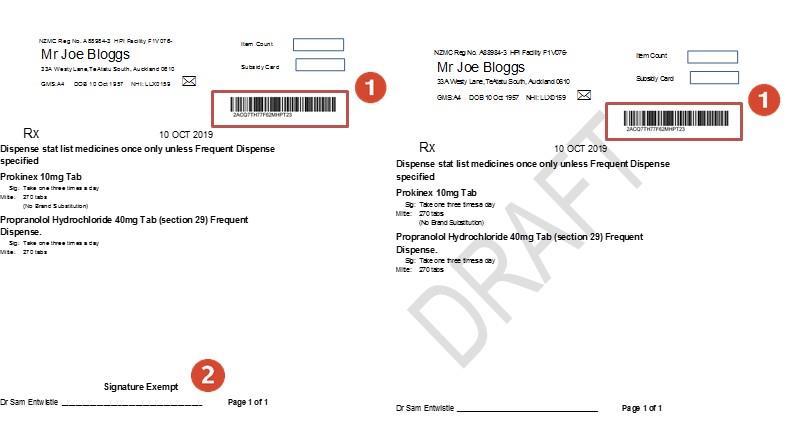Temporary Exemption for Signatures on Prescriptions without NZePS (without an NZePS barcode)
For other community and hospital prescribers that do not use a system that can integrate with NZePS, the Director General of Health authorised an alternative form of prescription that is not signed personally by a prescriber with their usual signature if they meet certain conditions, ensuring easy identification of the authorised prescriber and the healthcare facility. Many clinicians may be working away from their normal places of work and lack the equipment needed to print and scan or fax a signed prescription to a pharmacy. The “Director General authorisation of an alternative form of prescription pursuant to regulation 43 of the Medicines Regulations 1984”, will expire on the 31 October 2024
This temporary authorisation recognises prescriptions not signed personally by a prescriber with their usual signature as legal when all of the following conditions are met:
• the prescription is generated by an electronic system and requires the prescriber to log on with a unique ID and password;
• the prescription does not include Controlled Drugs (Class A, B or C) but can include a Class C exempted or partially exempted controlled drug as defined by the Misuse of Drugs Act 1975. Prescriptions with a Controlled Drug will continue to require an original wet ink prescriber signature. See Appendix 3 for the list of Class C Controlled Drugs. The classification for these Class C controlled drugs are also available on the NZ Formulary.
• the prescription includes all of the following:
o the prescriber’s registration authority number (e.g. MCNZ) that uniquely identifies the prescriber;
o the contact details of the prescriber to enable the pharmacy to contact the prescriber to verify identify or request amendments to the prescription; and
o the following statement “This Prescription meets the requirement of the Director General of Health’s authorisation of October 2022 for prescriptions not signed personally by a prescriber with their usual signature”.
• the prescription must be in a format that cannot be easily altered by anyone other than the prescriber (e.g. PDF, photograph);
• the prescription must be sent directly to the community pharmacy using a secure, electronic system to send that identifies the prescriber’s name and facility. The following would satisfy this requirement: o a secure email system that identifies the prescriber and the healthcare facility through its email address. A secure email is defined in the Secure Digital Communications within the NZ Health & Disability advisory from June 2019: https://www.health.govt.nz/system/files/documents/publications/joint acc moh advice on securing-email-and-fax-jun2019.pdf
o a secure clinical communication system that links prescriber and pharmacies such as the Electronic Request Management System.
o a fax from a number that is recognised by the pharmacy as a valid prescriber
• the electronic prescription is kept on and submitted as required by the Integrated Community Pharmacy Services Agreement (ICPSA) as a criterion for payment.
If amendments are required to the prescription, it is the prescribers’ responsibility to contact the pharmacy to check if the prescription has been dispensed, instruct the pharmacy to cancel the prescription and to send the pharmacy an amended prescription. Pharmacy must maintain a copy of the cancelled prescription and the amended prescription.
It is also a prescriber’s (not a pharmacy’s) responsibility to ensure that they only use this authorised alternative form of prescription (signature exempt) if their system is not technically capable of integrating with the NZePS.
This temporary authorisation does not affect NZePS Prescriptions (with barcode). The ability to generate signature exempt prescriptions when NZePS is used is an enduring capability subject to requirements detailed in Appendix 2 being met.
Except where a prescription contains one or more Class A, B or C controlled drugs (except Class C exempt or partially exempt controlled drugs), this Director General authorisation of an alternative form of prescription pursuant to regulation 43 of the Medicines Regulations 1984) means that the following arrangements apply until the 31October 2024:
• Pharmacies do not need to obtain original copies of non NZePS faxed/emailed prescriptions if the following conditions are met:
o each faxed prescription must otherwise be fully compliant with regulation 41 of the Medicines Regulations 1984; and
o the prescription must meet the requirements of the authorisation (see Appendix 1)
• Pharmacies do not need to match telephone or pharmacy generated prescriptions with a prescription signed by a general practitioner to claim for the dispensing if the following conditions are met:
o an electronic medication chart is used by the ARC facility, GP and pharmacy for prescribing, dispensing and administration;
o a telephone or pharmacy generated prescription is generated that matches the medication chart; and
o the telephone or pharmacy generated prescription is attached to the medication chart and is kept and submitted as required by the Integrated Community Pharmacy Services Agreement (ICPSA).
Vendors and organisations that wish to integrate with the NZePS can contact onlinehelpdesk@health.govt.nz with “NZePS Integration” in the subject line.
Example of a correctly written non-NZePS prescription:
On electronic prescriptions without a barcode there must be a statement that reads “This Prescription meets the requirement of the Director-General of Health’s authorisation of October 2022 for prescriptions not signed personally by a prescriber with their usual signature”

The prescription must also have:
• The registration authority number of the Prescriber (e g NZMC)


• The contact details of the prescriber.
If you have any questions about electronic prescribing, please visit the Ministry’s website: https://www.health.govt.nz/our-work/digital-health/other-digital-health-initiatives/emedicines/newzealand eprescription service/signature exempt prescriptions and remote prescribing

